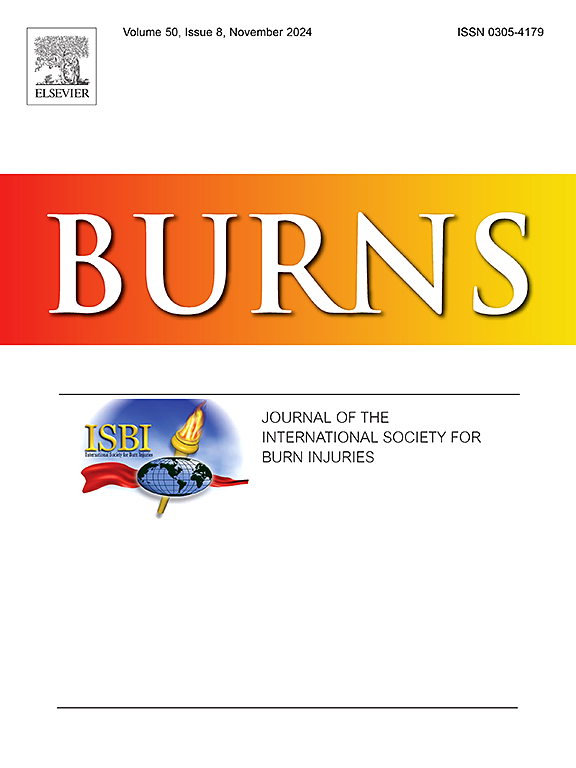烧伤后老年人的吞咽障碍:验证吞咽困难的发生率和预测因素。
IF 3.2
3区 医学
Q2 CRITICAL CARE MEDICINE
引用次数: 0
摘要
背景:早期回顾性数据显示,吞咽困难在烧伤老年人中很常见,比例高达 47%,并且与医疗、烧伤和营养结果相关。目的:前瞻性地(1)探讨烧伤住院患者(≥ 75 岁)的发病率,(2)描述相关性,(3)评估吞咽困难的风险因素:在4年(2019-2023年)内,协和-遣返总医院收治的所有年龄大于75岁的烧伤患者在入院时均接受了吞咽困难评估,并在整个入院期间接受持续监测。前瞻性地采集了烧伤、人口统计学和营养学数据,并分析了这些数据与吞咽困难的关系:共招募了 62 名患者(33 名男性),年龄在 75-95 岁之间(中位数=83 岁)。50%的患者被确认为吞咽困难。吞咽困难与烧伤面积(p = 0.002)、原有认知障碍(p = 0.000)、住院时间(p = 0.001)、院内并发症(p = 0.000)、喂养依赖(p = 0.002)、营养状况(p = 0.013)和肠道喂养持续时间(p = 0.030)有关。认知障碍是最敏感的吞咽困难预测指标,其敏感度为 100%(特异性=29%,NPV=100%,PPV=59%)。继发性合并症的敏感性较低,仅为 52%(NPV 65%),但特异性(90%)和 PPV(84%)都很高:结论:每两名年龄≥75 岁的烧伤患者中就有一人会在入院期间出现吞咽困难。已有认知障碍的患者风险最大。本文章由计算机程序翻译,如有差异,请以英文原文为准。
Swallowing impairment in older persons following burn injury: Validation of incidence and predictive factors for dysphagia
Background
Early retrospective data identify that dysphagia is common in older persons with burn injury, suggesting a rate of 47 %, and that it is associated with medical, burn, and nutritional outcomes.
Aims
To prospectively (1) explore the incidence, (2) describe associations, and (3) evaluate risk factors for dysphagia in patients ≥ 75 years old hospitalised with burn injury.
Methods
All patients > 75 years old admitted to Concord-Repatriation-General-Hospital with burn injury over 4 years (2019–2023) were assessed for dysphagia on presentation and were continually monitored throughout their admission. Burn injury, demographic, and nutritional data were prospectively captured and analysed for association with dysphagia.
Results
Sixty-two patients (33 male) aged 75–95 years (median=83 years) were recruited. Dysphagia was identified in 50 %. Dysphagia was associated with burn size (p = 0.002), pre-existing cognitive impairment (p = 0.000), hospital length of stay (p = 0.001), in-hospital complications (p = 0.000), feeding dependence (p = 0.002), nutritional status (p = 0.013) and enteral feeding duration (p = 0.030). Cognitive impairment was the most sensitive predictor for dysphagia at 100 % (specificity=29 %, NPV=100 %, PPV=59 %). Development of secondary comorbidities was less sensitive at 52 % (NPV 65 %), but was associated with high specificity (90 %) and PPV (84 %).
Conclusions
One in every two patients ≥ 75 years admitted with burn injury will demonstrate dysphagia during their hospital admission. Those with pre-existing cognitive impairment are most at risk.
求助全文
通过发布文献求助,成功后即可免费获取论文全文。
去求助
来源期刊

Burns
医学-皮肤病学
CiteScore
4.50
自引率
18.50%
发文量
304
审稿时长
72 days
期刊介绍:
Burns aims to foster the exchange of information among all engaged in preventing and treating the effects of burns. The journal focuses on clinical, scientific and social aspects of these injuries and covers the prevention of the injury, the epidemiology of such injuries and all aspects of treatment including development of new techniques and technologies and verification of existing ones. Regular features include clinical and scientific papers, state of the art reviews and descriptions of burn-care in practice.
Topics covered by Burns include: the effects of smoke on man and animals, their tissues and cells; the responses to and treatment of patients and animals with chemical injuries to the skin; the biological and clinical effects of cold injuries; surgical techniques which are, or may be relevant to the treatment of burned patients during the acute or reconstructive phase following injury; well controlled laboratory studies of the effectiveness of anti-microbial agents on infection and new materials on scarring and healing; inflammatory responses to injury, effectiveness of related agents and other compounds used to modify the physiological and cellular responses to the injury; experimental studies of burns and the outcome of burn wound healing; regenerative medicine concerning the skin.
 求助内容:
求助内容: 应助结果提醒方式:
应助结果提醒方式:


